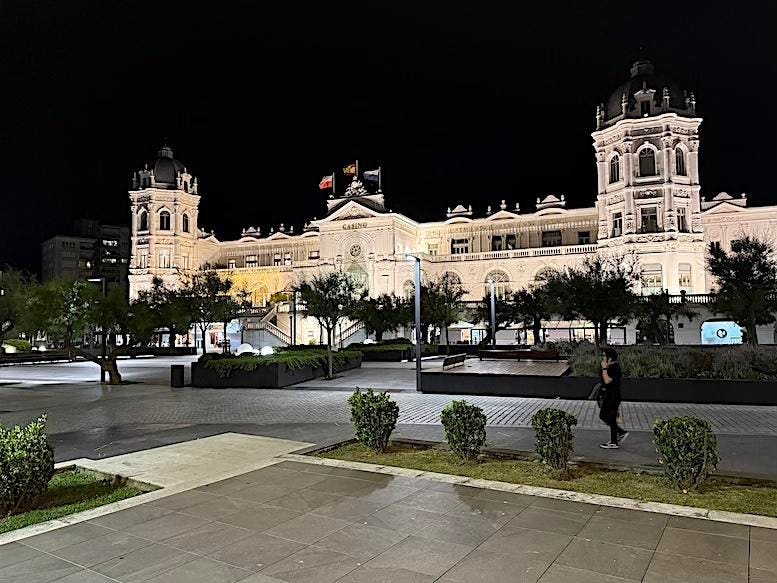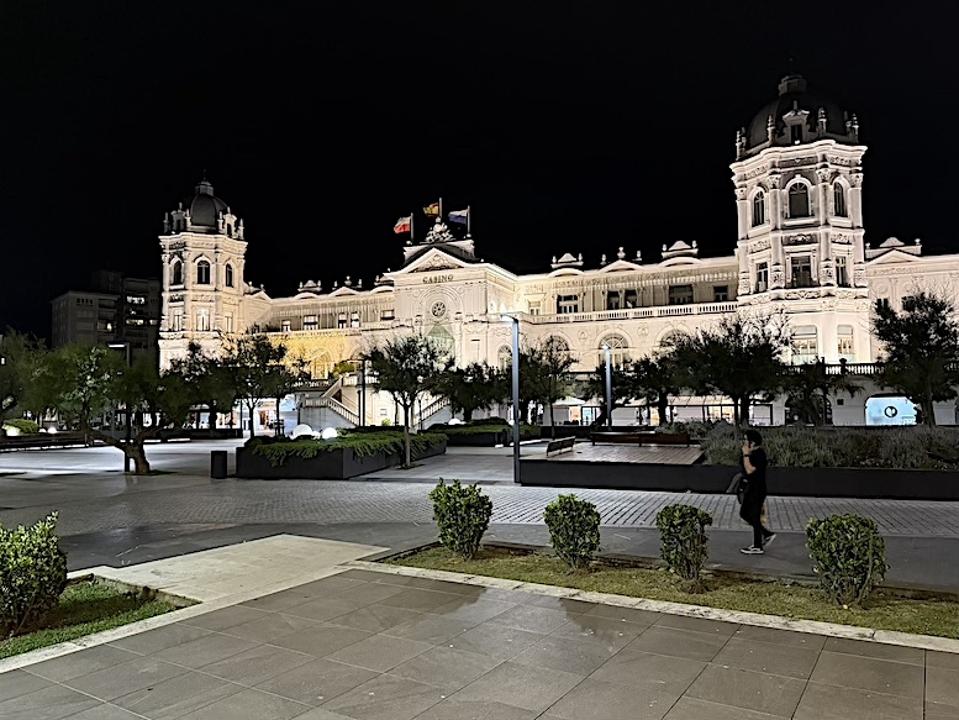The Casino in Santander dates to the 19th century but after a fire it was rebuilt to its current grandeur in 1916 and is one of the largest in Europe.
John Mariani
My friend had preceded me by three days when I arrived in Santander, a city in northern Spain about which I knew nothing but the bank of the same name. My friend, a surgeon, was there to give a talk to medical students, and I was to join him for a day or two before heading south to Madrid.
When I asked what he thought of the city, he said, “It’s wonderfully quiet, spacious and has a sense of peacefulness about it. I think I could retire here.” Which struck me as a very strange notion on his part because he’d spent his entire career in land-locked, sand-locked Tucson, Arizona, which Santander is nothing like.
The beach winds for miles along Santander’s peninsular.
John Mariani
After two days in the city I knew what my friend was feeling, for it is a wide-open city of long, winding boulevards along the Bay of Santander on La Magdalena Peninsula leading to the Cantabria Sea. It is the capital city of Cantabria with a modest population of under 200,000. Sadly, much of the city dating back to the 9th Century suffered a devastating fire that burned for two days and consumed much of the old medieval town, including the cathedral. As a result, the city was restored along modern lines after World War II, so that the curving Paseo de Pereda and Avenida de la Reina sweep the shore and beach of El Sardinero, one of the loveliest in Spain. Above it La Magdalena Royal Palace, a mix of turrets, balconies and timbered accents, was the summer residence of the king and his family, located near the elegant and majestic Hotel Real.
The Hotel Real is one of Santander’s luxury hotels on the plaza.
John Mariani
The rebuilding of the 12th century Our Lady of the Assumption Cathedral after the Great Fire took twelve years, but today it has the sheen of freshness, in the Gothic style with overlapping floors, crypt and an annex of cloisters.
Fortunately much of the old city has been reclaimed, and its weaving up-and-down streets are ideal for finding what’s behind the next corner. The Centro Botin, by architect Renzo Piano, opened in 2017, is a complex within the vast Pereda Gardens devoted to art, music and theater, which has given the city a high reputation for Spanish and international culture.
The Casino in Santander dates to the 19th century but after a fire it was rebuilt to its current grandeur in 1916 and is one of the largest in Europe.
(By the way, Banco Santander’s corporate headquarters, located for a century in the Pereda Building in Santander, is currently being transformed into a cultural and leisure space; the bank is now headquartered in Boadilla del Monte, Madrid.)
The Sardinia Grand Hotel Sardinera is modern within an historic building.
John Mariani
I stayed at the Grand Hotel Sardinero overlooking the beach, itself an historic building now thoroughly modernized. The standard rooms are fairly basic in décor but have good bathrooms, air-conditioning and easy access to the Internet. The breakfast buffet is satisfying if nothing special. The front desk staff can be helpful when they do not claim being too busy to be so. Currently rooms begin at a very reasonable €71.
Restaurante Los Peñucas is located near the fishing docks so its seafood is as fresh as it can be be each night.
John Mariani
Being a seashore town, Santander gets its pick of fresh seafood. Restaurante Los Peñucas Restaurante (C. Marqués de la Ensenada, 35; 942-22-9445) is very popular with the local people who come with their families to this expansive inside-and-out restaurant located where the fishermen bring in their catch each day. The décor is minimal, the lighting bright, the noise level remarkably moderate. You pass the open kitchen on your way in, seeing a brigade of cooks steaming, roasting and grilling seafood just brought in from the docks, which the day I visited included a splendid fat rodaballo (turbot). There are two pages of starters, including plump white asparagus in season, and 24 seafood items, sold by the kilogram, as well as a three-course plus glass of wine menu of the day at €20. Langoustines cooked on the plancha griddle were meaty and seared for a smoky flavor. The turbot was silky with its own fat, filleted at the table and served with fried potatoes and salad. The wine list is serviceable, stressing bottlings from Ribera del Duero, averaging €15. Tax and service are included.
T
The beautiful Asador Lechazo Aranda is famous for its roast suckling pig and baby lamb.
John Mariani
he next day I was ready for roast suckling pig and baby lamb, which are the stars of Spanish cuisine, so we went into the old part of town to Asador Lechazo Aranda (15 Terúan; 942-21-48-23), whose specialties include dishes roasted in a brick oven fired with aromatic wood. It’s open every day and its two main dining rooms start to fill up after one PM. Aranda has a long history in Santander as one of its best––though not expensive––restaurants, known for its stained glass ceiling and Castilian décor, with lovely lighting from sconces on old brick walls.
We started off with cod and potato croquetas and both a quarter of the suckling pig (€56), which came out sizzling, its aroma perfuming the room, its flesh glistening with melting fat and crackling skin. Practice has obviously made this preparation perfect here, and nothing is made in advance. We did our best to finish the pig, accompanied by cold Mahon beer, but it was futile. We’d need at least another person to polish it off. We saved the baby lamb for next time.

